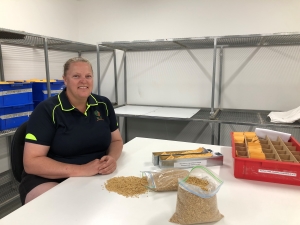Mouse hot spots in SA and Victoria cause concern ahead of sowing
Mouse hot spots in SA and Victoria cause concern ahead of sowing
Author: GRDC Adelaide office | Date: 03 Apr 2020

Mouse numbers are building to concerning levels in parts of Victoria and South Australia, posing a potential risk to this year’s winter crops.
The latest monitoring undertaken by the CSIRO through a Grains Research and Development Corporation (GRDC) research investment combined with on-the-ground reports from growers and advisers have led to experts warning of possible crop damage at sowing and in spring.
In Victoria, mouse abundance is moderate to high across the Wimmera and Mallee regions, while in SA, numbers are moderate to high on the northern Adelaide Plains, and moderate in the Mallee and on Eyre and Yorke Peninsulas.
Mouse numbers are expected to peak when many winter crops are sown over the coming weeks. Experts warn that if populations remain high, they will cause economic damage.
The increase in mouse activity in the Wimmera and Southern Mallee region is of particular concern. These regions have experienced conditions favouring mice – good spring and summer rains combined with an abundance of grain left on the ground following wind and storm damage prior to harvest last year, and thick stubble for habitat.
Birchip Cropping Group (BCG) senior operations manager, Kelly Angel, says Wimmera growers are “on high alert”.
“Growers need to be aware of the risks. We are in a similar situation to the start of the 2017 season – two years after a poor season, a good crop last year, plus large amounts of grain remaining in paddocks,” Ms Angel says.
“It is important that growers are actively monitoring mouse numbers, to know the extent of the risk they face.”
Ms Angel says that despite significant summer rains, visually unshot grain remains in paddocks, especially where it has been suspended off the ground by straw/stubble.
“So the assumption that the rains have germinated everything and therefore removed the feed source for mice is probably not entirely correct.”
While mouse chew cards are often an effective method of assessing numbers, Ms Angel says the abundance of food sources could negate their reliability.

“From a visual assessment, we know mice are in paddocks in large numbers, yet that is not being reflected with chew cards soaked in oil. Mice seem uninterested in the chew cards as they have plenty of real food at their disposal.”
Ms Angel also pointed out that mice appear to be using cracks in the ground as access to shelter, so purpose-built holes were not necessarily a sound indicator of mouse abundance.
GRDC-supported mouse researcher Steve Henry from CSIRO, Australia’s national science agency, warns that the increase in mouse numbers over autumn in some areas could result in higher than normal survival rates over winter if the crop growing season is a good one.
“This would then mean we enter spring with a larger than normal population of mice as crops advance to grain fill. This is why it is critical we make every effort to reduce numbers now.”
Mr Henry says large quantities of grain in paddocks could reduce the chance of mice finding toxic bait, while at the same time providing an ongoing food source.
“If strong winds have resulted in up to two tonnes/hectare of grain on the ground in some areas, that equates to up around 4000 grains per square metre,” Mr Henry says.
“The challenge for growers is to reduce the food load for mice in stubbles. Putting sheep on stubbles and strategic cultivation (burying grain) will assist with food reduction, and growers should spray out any summer germinations. Seeding with knife points assists in burying residual seed – potentially enhancing bait uptake.”
Mr Henry emphasised the importance of bait application timing.
“It is critical that growers bait six weeks out from seeding if mouse numbers are high, and then follow up with another bait application off the back of the seeder if numbers are still high at sowing.
“A six-week break between applications avoids the risk of bait aversion. However, if growers haven’t already baited and are planning to sow crops towards the end of April or early May, that ideal baiting window may have closed.”
Zinc phosphide bait must be spread according to the label rate of one kilogram per hectare.
Mr Henry urged growers to walk into paddocks to obtain an accurate understanding of current conditions in terms of the amount of grain on the ground and signs of mouse activity. High stubble loads hide the signs of mouse activity.
“I also urge growers to report and map mouse activity – presence and absence – using MouseAlert and via Twitter using @MouseAlert so other growers can see what activity is being observed in their neighbourhood.”
Concerns about the increase in mouse numbers over recent months have been discussed by the National Mouse Group (NMG), a GRDC investment. The NMG, which co-ordinates actions to counter mouse plagues, comprises researchers, advisers, growers and other industry stakeholders.
Meanwhile, the GRDC has invested in a major mouse-related research, development and extension program that is continuing to reveal new insights about mice in Australian broad acre cropping systems. The work is investigating mouse biology, ecology and bait efficacy.
Results from current research efforts will form the basis of a series of recommendations for improved mouse control strategies for Australian grain growers.
For further information, a comprehensive GRDC Mouse Control resource hub is available.
Contact Details
For Interviews
Kelly Angel, BCG
0427 564 507
Steve Henry, CSIRO
0428 633 844
Contact
GRDC Adelaide office Communications Manager – South
(08) 8198 8400
media@grdc.com.au
GRDC Project Code: CSP1806-017RTX, CSP1804-012RTX, CSP1806-015RTX,
